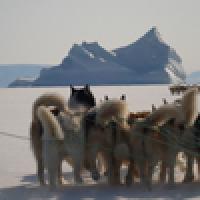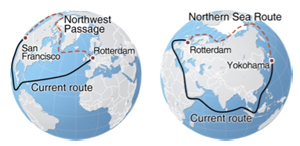
Further evidence for Arctic melt-down

The summer of 2007 saw a record low in sea ice extent. Image: National snow and ice data centre.
The worrying decline of Arctic sea ice as a result of global warming is continuing. Last month the results of the Catlin Arctic Survey, an expedition to measure the thickness of Arctic sea ice, were presented at a press conference called by the World Wildlife Fund. On their 434km trek across the Arctic the explorers measured an average ice thickness of 1.77m. This confirms that the ice is getting thinner, but also means that they encountered mainly young ice, rather than the older and thicker multi-year ice they had expected. "This part of the Arctic always used to have older ice," says Peter Wadhams, Head of the Polar Ocean Physics Group at the University of Cambridge, who was scientific adviser to the expedition. "The results give further evidence that the older ice is retreating into just one corner of the Arctic."
Arctic sea ice has become thinner by around 43% over the last 25 years. This is a worrying trend because scientists believe that it is through thinning that the ice will eventually break up and disappear completely. But the area covered by sea ice has also shrunk dramatically: summer sea ice extent saw an unprecedented slump in 2007, increasing the rate of shrinkage per decade from around 4% to around 9%. In the summer of 2008 both the Northwest passage and the Northern sea route, connecting the Atlantic and Pacific oceans, were free of ice and accessible to shipping for the first time. And while the ice does return in the winter, it does so more slowly, with November sea ice cover reaching a record low in 2009.

Ice-free passages between the Atlantic and Pacific oceans mean drastically shortened shipping routes. Image: European Environment Agency.
Based on these figures, scientists now predict that, at a conservative estimate, the summer sea ice cover will disappear completely in twenty to thirty years' time. These predictions come from complex mathematical models, which take account of a wide variety of factors that impact on sea ice behaviour, from global ocean circulation systems to the thermodynamics of the ice. The Intergovernmental Panel on Climate Change (IPCC) currently uses twelve such models, and bases its predictions on an average of their outputs.

Polar bears are unlikely to survive if summer sea ice cover disappears. Photo: Peter Wadhams.
But how confident can we be that the predictions of these models are accurate? The alleged suppression of climate change data at the University of East Anglia, and the inaccuracy in an IPCC report concerning Himalayan glaciers have weakened public faith in climate science, and the 2007 slump has indeed led to some overly dramatic predictions of an ice-free Arctic within five years.
However, comparing the sea ice extent that had been predicted by the IPCC models for recent years with what was actually observed shows that the models, as they stand, underestimate the rate at which the ice is disappearing. Wadhams believes that this is due to feedback loops which come into play as more ice melts in the summer, but which have not yet been properly accounted for in the models. Melting ice gathers into melt ponds of warmer water. If these thaw through completely, then the warmer water raises the surface temperature of the ocean and flows underneath ice floes, melting them from below. Melt ponds also have an effect on the Arctic's albedo, the proportion of solar radiation that is reflected back into space. Less ice means a smaller area of white to reflect the radiation, more radiation is absorbed, which leads to further heating and yet more melt. "Making a systematic error in albedo is enough to throw the model prediction of ice thickness off," says Wadhams. "The effect of melt water on both the ocean temperature and on the albedo are currently not properly modelled [in the IPCC models]."

Sledging on first-year sea ice off Qanaq, NW Greenland. The iceberg in the distance is frozen into the sea ice. Photo: Peter Wadhams.
It is possible to tweak the existing models to take account of these factors by building the mathematics that describes the underlying physical processes into the equations. The prediction quoted above — of an ice-free Arctic within twenty to thirty years' time — is based on the output of just two of the IPCC models, whose results fit observed data better than those of the combined twelve. Wadhams believes that it's a reasonably accurate prediction, if a little conservative. "What will probably happen is that the ice will first retreat quite quickly, until in about ten years we are down to a fairly small region north of Greenland and Ellesmere Island, where you have thicker multi-year ice — that's about a half or a third of the present summer area. Then that will survive longer because it is thicker and might last another twenty years. So twenty to thirty years is a good conservative figure, though I suspect that the ice will go faster than that."

An upside-down view of the underside of the ice, created using multi-beam sonar. Image: Peter Wadhams.
Wadhams is not himself directly involved in building the IPCC models. His research team's work in the Arctic focuses on gathering and analysing raw data to find out just how fast the ice is melting and what kind of physical processes are involved in the melt. His team have been using submarines and autonomous underwater vehicles (AUVs) travelling under the ice to measure its thickness using sonar. They are analysing data from multi-beam sonar captured from AUVs, which give 3D coverage of ice along the tracks that the vehicle has travelled. Wadhams hopes that the data will give further insight into exactly what's involved in the melt process and why some of the most prominent features of Arctic sea ice — pressure ridges that can loom up to 8m high and reach a depth of 50m below the surface — are disappearing. Meanwhile, the Catlin Arctic Survey has set out on a second expedition, this time to investigate the effects of carbon dioxide on the Arctic ocean.
There now is no doubt in the scientific community that the Arctic ice cap is melting, and that this is due to man-made global warming. Research like that carried out by Wadhams' group has been essential in establishing what exactly is happening in the Arctic and in predicting what will happen in the future. We now need to prepare for the biological and geopolitical impacts of an ice-free Arctic.
Further reading
- To find out more about Peter Wadhams' work and the basics of sea ice modelling, read the Plus article Maths and climate change: the melting Arctic;
- In conjunction with the Catlin Arctic Survey we have produced a package of resources for teachers and students, exploring the maths involved in such an expedition, from navigation to climate models and statistical analysis.
Comments
Marianne
"There now is no doubt in the scientific community that the Arctic ice cap is melting, and that this is due to man-made global warming."This is nonsense.Man-made global warming is a theory which is increasingly at variance with the facts;there has been no statistically significant global warming for at least a decade. There is no consensus and just repeating a statement does not make it true.
"The Arctic Ocean covers 5,427,000 square miles. Catlin 2010 has seen maybe ten square miles of it, meaning they have sampled less than 0.0002% of the ice. They also choose to travel on refrozen leads because they are flatter and smoother, so their sampling is not random. No serious scientist would attempt to draw any conclusions about the quality of the ice based on a cherry picked sample representing less than 0.0002% of the Arctic" Taken from Watts up With That to provide some balance.
Marianne
What to add to what Pyrrho said?
Global Warming is indeed a 'litmus test' and +Plus Magazine is failing it at this time. Anthropogenic Global Warming is a fraud perpetrated by others for their political/genocidal agenda but now since 'AGW' can't be sustained it is now 'Climate Change'. Before it was turned into this circus 'Scientists' were worried about a new Ice Age...feeling kind of chilly in Britian about now I suppose! The Sun is the arbiter of our weather and was understood to be so at least until it was time to reduce the worlds population and use any method for doing so. If you liked Science under Stalin you'll just love it under 'GW' and it's political proponents.
+Plus Magazine should know better!!!
Marianne
"Anthropogenic Global Warming is a fraud perpetrated by others for their political/genocidal agenda"
And you know this how exactly?
Do you disbelieve thousands of scientists? are they all in it together and to what end?